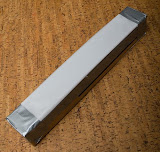SPOY 5th Place: You Be The Judge
 The very cool 3rd-place "Ants at the Trough" photo, by Peter Steeper, showed a 2007 date in the Flickr system, but was in fact taken in 2003. This being the 2007 Strobist Photos of the Year, Peter and I mutually agreed to remove it from consideration after the fact.
The very cool 3rd-place "Ants at the Trough" photo, by Peter Steeper, showed a 2007 date in the Flickr system, but was in fact taken in 2003. This being the 2007 Strobist Photos of the Year, Peter and I mutually agreed to remove it from consideration after the fact.Given that the contest was for photos taken in 2007, we both felt it the fairest course of action. Mind you, it's still a kick-butt photo, and Peter should be very proud of it. Other arrangements are being made in thanks for Peter's gracious handling of the date confusion.
With a hole left in the top five photos, and five honorable mentions waiting at the ready, and Chase Jarvis inconveniently en route to Paris as I type this post, we are left with a decision as to what to do.
That's where you come in. Hit the jump for details.
_________________________
First of all, 5th place moves to 4th, and 4th moves to 3rd. Which now leaves the hole at 5th.
Problem: Where to find a judge on such short notice to determine which of the honorable mentions gets bumped up to 5th?
Solution: The 5th place slot now becomes a Peoples' Choice, from the remaining honorable mentions. They are listed below, in no particular order. (Please note the number by each photo. )
The members of the Strobist Flickr Group have all been deputized as 5th-Place, Peoples' Choice Judges. You will be choosing one, and only one. We, uh, you will vote simply by leaving a post in the thread linked below and stating the number 1, 2, 3, 4 or 5.
Please vote only once. Any instance of duplicate votes will result in none of your votes being counted. You may change your vote at any time via the edit function. If you wish to lobby, please do so in the SPOY Discussion Thread instead of within the voting thread. And please keep your lobbying to being in favor of a particular image, rather than trashing another one.
IMPORTANT: Your post in the voting thread should contain one digit: 1-5. Simply cast your vote by typing a number.
The voting closes as of the end of 2007, which is about 22 hours from now, Eastern Time US. You'll know voting is closed because we have arranged for a shiny ball to drop down in Time Square in New York City to mark the closing of the polls. Any votes cast after that time will not be counted. We are arranging to have the NYC vote-closing ceremony televised, too. Check local listings in the US.
Without further ado, here are your five honorable mentions from which to choose. You may click through from any of the photos to see the photo's Flickr page for more information.
__________________________
Number 1
Number 2
Number 3
Number 4
Number 5
_________________________________
I am very curious to see how smoothly this goes. If it works, it could pave the way for an all-peoples' choice 2008 SPOY. Assuming there is a 2008 SPOY.
Please vote here.
Thanks for your help!
__________
New to Strobist? Start here | Or jump right to Lighting 101
My new book: The Traveling Photograher's Manifesto
Permalink










